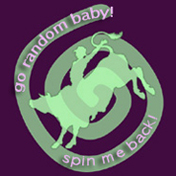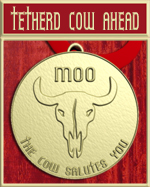Entries tagged with “Photography”.
Did you find what you wanted?
Thu 22 Apr 2010
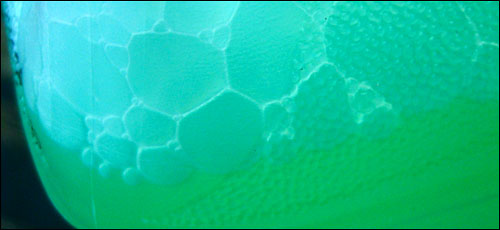
Ingredients:
•150ml Glycerine
•100g KY jelly
•1 level tspn sodium bicarbonate (baking soda)
•1½ cups detergent concentrate
•1 cup hot water
•Filtered water to make up 2 litres
Hardware:
•1 x 2 litre plastic bottle
•1 small bucket
•2 x 1 metre lengths of wooden dowel
•5m natural fibre string

Method:
Dissolve the sodium bicarbonate in the hot water. Carefully mix in ½ cup of the detergent, all the glycerine and the KY jelly. Stir until dissolved as much as possible. Pour about 1 litre of cold water into the 2 litre bottle. Slowly pour in the remaining 1 cup of detergent, taking care not to make foam. Very slowly add the warm glycerine/KY/detergent/water mix. Add water to bring to 2 litres.
Gently rotate the bottle until the contents are mixed as much as possible (there will probably still be undissolved NaHCO3 and visible threads of KY & glycerine – don’t worry). Leave the bottle to stand for 2 days.

Meanwhile braid the string into a loop about the size of a basketball and attach to the ends of the dowel like this:
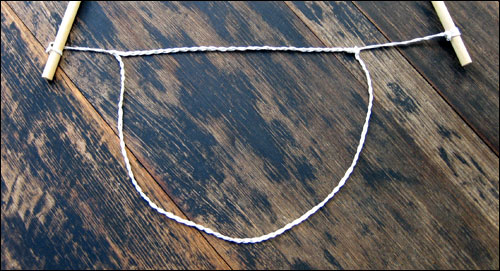
After two days have passed, check the solution and make sure it is completely uniform – there should now be no visible traces of any of the individual ingredients.
Now, go to a park or a beach – somewhere sheltered and not too hot. Pour some of the solution into the small bucket and dip the string into it – make sure you get it nice and saturated. Now do this:
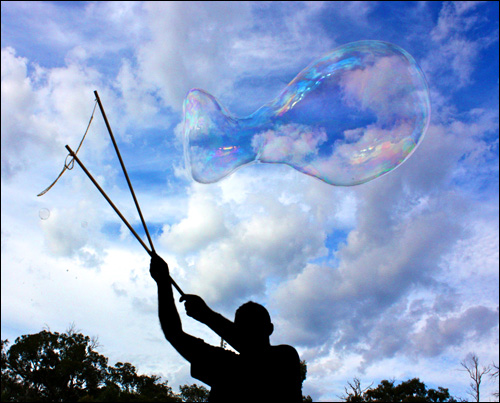
You might even be able to make one like this…
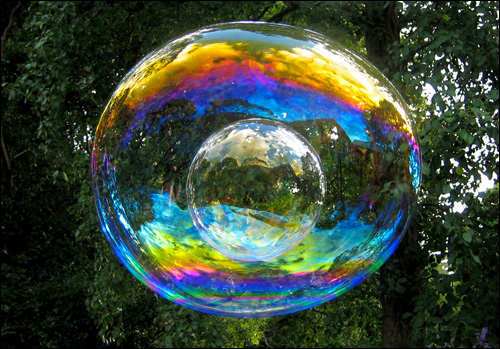
Science! Just because something isn’t imaginary doesn’t mean you can’t believe in it…

___________________________________________________________________________
Bubble photos by Violet Towne.
___________________________________________________________________________
Sat 22 Aug 2009

I’ve become completely addicted to this little app for the iPhone called CameraBag. It basically lets you take iPhone snaps and apply various filters to them. It’s nothing you couldn’t do in Photoshop, and the quality is kinda crap, but there’s an immediacy and grit to the whole process that reminds me of my old Polaroid days. Except it’s about a billion times cheaper.
(Seriously! Does anyone remember how expensive Polaroid film was? I think for my treasured SX-70 Alpha I got ten shots for something like 15 or maybe even 20 dollars. And that was a lot more money in those days…)
Wed 6 Aug 2008
GEEK ALERT!: Another camera mod that will probably have minimal interest for most of you, but I’m posting it up because I think it’s cool, and because I think you need to know.
The other day I happened to be listening to a podcast that mentioned in passing that over-exposed, processed colour negative film is mostly opaque to all visible light, but readily transmits infrared. The over-exposed bit of the neg looks ‘black’ on the neg strip. It’s actually a very deep blue to the naked eye if you hold it up to a strong light:

Translating: the ‘blue’ bit in the negative above allows infrared light to pass through. “Well, what the hell use is that, Rev!” I can hear you say. “Our eyes can’t see into the infrared!”
Aha! Your eyes can’t, Faithful Acowlyte, but maybe your digital camera can… To check, find a TV remote and press any button on it while pointing it at the camera lens. If the display allows you to see a light blinking on the end of the remote, then the camera’s chip sees infrared. This means (I can see you’re ahead of me now) that you can record infrared images!
Why would you want to do that? Because it’s pretty and mysterious! Isn’t that reason aplenty!? Just clip a piece of the end of an old neg, tape it over your camera lens and Bob’s yer uncle! The film knocks the exposure way down so for best results, set your camera ISO on its lowest setting and use a tripod and a longer exposure. If your camera is a Canon point-and-shoot, you may be able to hack the firmware to get exposure times of up to sixty seconds.
Now, for some striking results, go photograph some vegetation. Here’s a lily in my backyard. The leaves are actually a deep rich green, but because plants reflect so much infrared light (they can’t use it for photosynthesis) their foliage appears red, and sometimes even almost white.
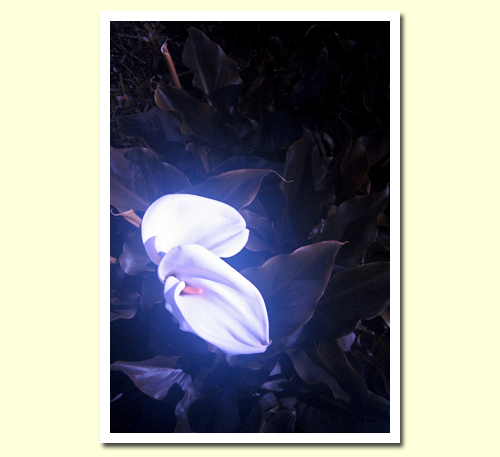
Now. How to record ultraviolet…?
Cow Cool Rating: ☆☆☆☆☆











